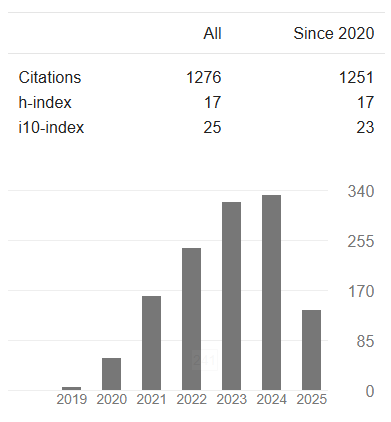Examining the Determinants of Ecological Footprint in ASEAN-5 Countries
DOI:
https://doi.org/10.14421/EkBis.2024.8.2.2337Keywords:
Ecological Footprint, Manufacturing, Household Consumption, Agriculture, InstitutionalAbstract
This study focuses on the ecological footprint as a crucial indicator for assessing the environmental impact of human activities, particularly in the manufacturing sector, household consumption, and agriculture in five ASEAN countries (Indonesia, Malaysia, Singapore, Thailand, and the Philippines). The novelty of this study lies in the empirical analysis of the relationship between the ecological footprint and major sectors in ASEAN countries using panel data for 22 years (2000–2022). This study uses panel data regression with moderating variables to test the interaction between independent variables and the ecological footprint. The findings indicate that the manufacturing sector has a significant effect on the ecological footprint. The manufacturing sector can reduce its ecological footprint by implementing energy efficiency technologies and using environmentally friendly raw materials. Meanwhile, household consumption does not have a direct effect, but under specific circumstances, it can affect the ecological footprint, particularly the consumption of goods or services that excessively utilize natural resources and are not readily recyclable. The agricultural sector tends to increase its ecological footprint due to inappropriate practices, such as forest burning for agricultural expansion. The conversion of natural land to agricultural land also increases the levels of hazardous substances such as nitrogen and phosphorus in the soil, which have a significant impact on the ecosystem. The findings of this study provide new insights into effective governance strategies to support sustainable development. This study demonstrates that governance plays a major role in managing ecological footprints, emphasizing the significance of government intervention. The implication of this study is the need for policies that support environmentally friendly practices to reduce ecological footprints in the ASEAN-5 countries.
Downloads
 Abstract viewed: 338 times
|
Abstract viewed: 338 times
|
 PDF downloaded = 313 times
PDF downloaded = 313 times
References
Abd’Razack, N. T. A., Medayese, S. O., & Martins. (2021). Comparative Analysis of Ecological Footprint of Urban and Rural Households in Minna Emirate of Niger State, Nigeria. Journal of Inclusive Cities and Built Environment, 1(2), 41–54. https://doi.org/10.54030/2788-564x/2021/v1i2a5
Abdunnur. (2020). Nexus of fisheries and agriculture production and urbanization on ecological footprint: New evidence from Indonesian economy. International Journal of Energy Economics and Policy, 10(3), 190–195. https://doi.org/10.32479/ijeep.9172
Ahmed, Z., Wang, Z., Mahmood, F., Hafeez, M., & Ali, N. (2019). Does globalization increase the ecological footprint? Empirical evidence from Malaysia. Environmental Science and Pollution Research, 26(18), 18565–18582. https://doi.org/10.1007/s11356-019-05224-9
Aktürk, E., & Gültekin, S. (2024). The impact of food production on ecological footprint in Turkey: an analysis across agriculture, livestock, and aquaculture. Environment, Development and Sustainability, 0123456789. https://doi.org/10.1007/s10668-024-04944-4
Ashery, S. F. (2022). Group Consumption and Ecological Footprint: The Effect of Habits and Lifestyle. Sustainability (Switzerland), 14(20). https://doi.org/10.3390/su142013270
Athira, R., & Subha, V. (2013). Recent Advances in Structural Engineering. American Journal of Engineering Research, 12–19. www.ajer.org
Bhandari, K. R., Ranta, M., & Salo, J. (2022). The resource-based view, stakeholder capitalism, ESG, and sustainable competitive advantage: The firm’s embeddedness into ecology, society, and governance. Business Strategy and the Environment, 31(4), 1525–1537. https://doi.org/10.1002/bse.2967
Bohdanowicz, Z., Łopaciuk-Gonczaryk, B., Kowalski, J., & Biele, C. (2021). Households’ electrical energy conservation and management: An ecological breakthrough, or the same old consumption-growth path? Energies, 14(20). https://doi.org/10.3390/en14206829
Boluk, G., & Karaman, S. (2024). The impact of agriculture, energy consumption and economic growth on ecological footprint: testing the agriculture-induced EKC for Türkiye. Environment, Development and Sustainability, 26(12), 31817–31837. https://doi.org/10.1007/s10668-024-04672-9
Bull, J. W., Suttle, K. B., Gordon, A., Singh, N. J., & Milner-Gulland, E. J. (2013). Biodiversity offsets in theory and practice. Oryx, 47(3), 369–380. https://doi.org/10.1017/S003060531200172X
C2ES. (2007). A Climate of Change: Manufacturing Must Rise to the Risks and Opportunities of Climate Change. https://www.c2es.org/document/a-climate-of-change-manufacturing-must-rise-to-the-risks-and-opportunities-of-climate-change/
Castellani, V., Sanyé-Mengual, E., & Sala, S. (2021). Environmental impacts of household goods in Europe: a process-based life cycle assessment model to assess consumption footprint. International Journal of Life Cycle Assessment, 26(10), 2040–2055. https://doi.org/10.1007/s11367-021-01987-x
Chiobi, C. J., Joseph, R. T., Chiobi, A., & Omeje, A. N. (2023). Impact of Household Consumption on Ecological Footprint in Nigeria. 18(10), 87–116. https://doi.org/10.5110/77.
Destek, M. A. (2021). Deindustrialization, reindustrialization and environmental degradation: Evidence from ecological footprint of Turkey. Journal of Cleaner Production, 296, 126612. https://doi.org/10.1016/j.jclepro.2021.126612
Dogan, E., Taspinar, N., & Gokmenoglu, K. K. (2019). Determinants of ecological footprint in MINT countries. Energy and Environment, 30(6), 1065–1086. https://doi.org/10.1177/0958305X19834279
Doytch, N., Ashraf, A., & Nguyen, C. P. (2024). Foreign Direct Investment and Forest Land: A Sectoral Investigation. Environmental and Sustainability Indicators, 22(October 2023), 100353. https://doi.org/10.1016/j.indic.2024.100353
Epo, B. N., & Nochi Faha, D. R. (2020). Natural Resources, Institutional Quality, and Economic Growth: an African Tale. European Journal of Development Research, 32(1), 99–128. https://doi.org/10.1057/s41287-019-00222-6
Gaussin, M., Hu, G., Abolghasem, S., Basu, S., Shankar, M. R., & Bidanda, B. (2013). Assessing the environmental footprint of manufactured products: A survey of current literature. International Journal of Production Economics, 146(2), 515–523. https://doi.org/10.1016/j.ijpe.2011.12.002
Genta, C., Sanyé-Mengual, E., Sala, S., & Lombardi, P. (2022). The Consumption Footprint as possible indicator for environmental impact evaluation at city level. The case study of Turin (Italy). Sustainable Cities and Society, 79(August 2021). https://doi.org/10.1016/j.scs.2022.103679
Gerdessen, J. C., & Pascucci, S. (2013). Data envelopment analysis of sustainability indicators of european agricultural systems at regional level. Agricultural Systems, 118, 78–90. https://doi.org/10.1016/j.agsy.2013.03.004
GFN. (2020). Global Footprint Network, Advancing the Science of Sustainability.
Hermawan, A. N., Masudin, I., Zulfikarijah, F., Restuputri, D. P., & Shariff, S. S. R. (2024). The effect of sustainable manufacturing on environmental performance through government regulation and eco-innovation. International Journal of Industrial Engineering and Operations Management, 6(4), 299–325. https://doi.org/10.1108/ijieom-04-2023-0039
Ivanova, D., Stadler, K., Steen-Olsen, K., Wood, R., Vita, G., Tukker, A., & Hertwich, E. G. (2016). Environmental Impact Assessment of Household Consumption. Journal of Industrial Ecology, 20(3), 526–536. https://doi.org/10.1111/jiec.12371
Jackson, T. (2005). Motivating Sustainable Consumption. A Review of Evidence on Consumer Behaviour and Behavioural Change In A Report to the Sustainable Development Research Network as Part of the ESRC Sustainable Technologies Programme Centre for Environmental Strategy University of Surrey Guildford, 15(January), 1027–1051. https://doi.org/10.1260/0958305043026573
Javed, A., Subhani, B. H., Javed, A., & Rapposelli, A. (2024). Accessing the efficacy of green growth, energy efficiency, and green innovation for environmental performance in top manufacturing nations in the framework of sustainable development. In Quality and Quantity (Issue 0123456789). Springer Netherlands. https://doi.org/10.1007/s11135-024-01918-6
Jiang, Q., Matsuzaki, Y., Li, K., & Uitto, J. (2022). Transcriptional regulation and characterization of the promoter region of the human ABCC6 gene. Journal of Investigative Dermatology, 126(2), 325–335. https://doi.org/10.1038/sj.jid.5700065
Kellens, K., Mertens, R., Paraskevas, D., Dewulf, W., & Duflou, J. R. (2017). Environmental Impact of Additive Manufacturing Processes: Does AM Contribute to a More Sustainable Way of Part Manufacturing? Procedia CIRP, 61(Section 3), 582–587. https://doi.org/10.1016/j.procir.2016.11.153
Khan, I., Hou, F., Le, H. P., & Ali, S. A. (2021). Do natural resources, urbanization, and value-adding manufacturing affect environmental quality? Evidence from the top ten manufacturing countries. Resources Policy, 72(February), 102109. https://doi.org/10.1016/j.resourpol.2021.102109
Khan, M. S., & Uddin, M. S. (2018). Household Level Consumption and Ecological Stress in an Urban Area. Urban Science, 2(3), 56. https://doi.org/10.3390/urbansci2030056
Lawal, A. I. (2023). The Nexus between Economic Growth, Energy Consumption, Agricultural Output, and CO2 in Africa: Evidence from Frequency Domain Estimates. Energies, 16(3). https://doi.org/10.3390/en16031239
Li, J., Yuan, Y., & Luo, S. (2021). Raw Material Consumption Controls on Environment Impacts of Sofa Production: A Case Study Based on Ecological Footprint. Wuhan University Journal of Natural Sciences, 26(6), 527–534. https://doi.org/10.1051/wujns/2021266527
Liu, J., Yang, Q., Zhang, Y., Sun, W., & Xu, Y. (2019). Analysis of CO2 emissions in China’s manufacturing industry based on extended logarithmic mean division index decomposition. Sustainability (Switzerland), 11(1). https://doi.org/10.3390/su11010226
Liu, X., Zhang, S., & Bae, J. (2017). The impact of renewable energy and agriculture on carbon dioxide emissions: Investigating the environmental Kuznets curve in four selected ASEAN countries. Journal of Cleaner Production, 164, 1239–1247. https://doi.org/10.1016/j.jclepro.2017.07.086
Makhdum, M. S. A., Usman, M., Kousar, R., Cifuentes-Faura, J., Radulescu, M., & Balsalobre-Lorente, D. (2022). How Do Institutional Quality, Natural Resources, Renewable Energy, and Financial Development Reduce Ecological Footprint without Hindering Economic Growth Trajectory? Evidence from China. Sustainability (Switzerland), 14(21). https://doi.org/10.3390/su142113910
Mehmood, U., Agyekum, E. B., Kotb, H., Milyani, A. H., Azhari, A. A., Tariq, S., Haq, Z. ul, Ullah, A., Raza, K., & Velkin, V. I. (2022). Exploring the Role of Communication Technologies, Governance, and Renewable Energy for Ecological Footprints in G11 Countries: Implications for Sustainable Development. Sustainability (Switzerland), 14(19), 1–13. https://doi.org/10.3390/su141912555
Moriarty, P., & Honnery, D. (2021). The risk of catastrophic climate change: Future energy implications. Futures, 128, 102728. https://doi.org/https://doi.org/10.1016/j.futures.2021.102728
Muoneke, O. B., Okere, K. I., & Nwaeze, C. N. (2022). Agriculture, globalization, and ecological footprint: the role of agriculture beyond the tipping point in the Philippines. Environmental Science and Pollution Research, 29(36), 54652–54676. https://doi.org/10.1007/s11356-022-19720-y
Olanipekun, I. O., Olasehinde-Williams, G. O., & Alao, R. O. (2019). Agriculture and environmental degradation in Africa: The role of income. Science of The Total Environment, 692, 60–67. https://doi.org/https://doi.org/10.1016/j.scitotenv.2019.07.129
Rafique, M. Z., Nadeem, A. M., Xia, W., Ikram, M., Shoaib, H. M., & Shahzad, U. (2022). Does economic complexity matter for environmental sustainability? Using ecological footprint as an indicator. Environment, Development and Sustainability, 24(4), 4623–4640. https://doi.org/10.1007/s10668-021-01625-4
Rees, W. E. (1992). Ecological footprints and appropriated carrying capacity: What urban economics leaves out. Environment & Urbanization, 4(2), 121–130. https://doi.org/10.1177/095624789200400212
Salari, T. E., Roumiani, A., & Kazemzadeh, E. (2021). Globalization, renewable energy consumption, and agricultural production impacts on ecological footprint in emerging countries: using quantile regression approach. Environmental Science and Pollution Research, 28(36), 49627–49641. https://doi.org/10.1007/s11356-021-14204-x
Salo, M., Nissinen, A., Lilja, R., Olkanen, E., O’Neill, M., & Uotinen, M. (2016). Tailored advice and services to enhance sustainable household consumption in Finland. Journal of Cleaner Production, 121, 200–207. https://doi.org/10.1016/j.jclepro.2016.01.092
Shahbaz, P., & Haq, S. ul. (2022). Food-Energy-and-Water-Nexus-at-Household-Level-Do-Sustainable-Household-Consumption-Practices-Promote-Cleaner-EnvironmentInternational-Journal-of-Environmental-Research-and-Public-Health.pdf.
Sheahan, M., & Barrett, C. B. (2017). Ten striking facts about agricultural input use in Sub-Saharan Africa. Food Policy, 67, 12–25. https://doi.org/10.1016/j.foodpol.2016.09.010
Silva, N., & Molina-Besch, K. (2023). Replacing plastic with corrugated cardboard: A carbon footprint analysis of disposable packaging in a B2B global supply chain—A case study. Resources, Conservation and Recycling, 191(November 2022), 106871. https://doi.org/10.1016/j.resconrec.2023.106871
Silva, N. S. M., & Santos, E. M. (2022). Internationalization in English language courses within Languages without Borders. Letras, 333–353. https://doi.org/10.5902/2176148543163
Stanley, T. D., & Jarrell, S. B. (1989). Meta-Regression Analysis: A Quantitative Method of Literature Surveys. Journal of Economic Surveys, 3(2), 161–170. https://doi.org/https://doi.org/10.1111/j.1467-6419.1989.tb00064.x
Sun, Y., Gao, P., Raza, S. A., & Khan, K. A. (2023). The nonparametric causal effect of sustainable governance structure on energy efficiency and ecological footprint: A pathway to sustainable development. Gondwana Research, 121, 383–403. https://doi.org/https://doi.org/10.1016/j.gr.2023.05.007
Tverberg, G. E. (2012). Oil supply limits and the continuing financial crisis. Energy, 37(1), 27–34. https://doi.org/https://doi.org/10.1016/j.energy.2011.05.049
Udemba, E. N. (2020). Mediation of foreign direct investment and agriculture towards ecological footprint: a shift from single perspective to a more inclusive perspective for India. Environmental Science and Pollution Research, 27(21), 26817–26834. https://doi.org/10.1007/s11356-020-09024-4
Ulucak, R., & Lin, D. (2017). Persistence of policy shocks to Ecological Footprint of the USA. Ecological Indicators, 80(May), 337–343. https://doi.org/10.1016/j.ecolind.2017.05.020
Usman, M., & Makhdum, M. S. A. (2021). What abates ecological footprint in BRICS-T region? Exploring the influence of renewable energy, non-renewable energy, agriculture, forest area and financial development. Renewable Energy, 179, 12–28. https://doi.org/https://doi.org/10.1016/j.renene.2021.07.014
Uzar, U. (2021). The relationship between institutional quality and ecological footprint: Is there a connection? Natural Resources Forum, 45(4), 380–396. https://doi.org/10.1111/1477-8947.12235
Vachon, S., & Klassen, R. D. (2008). Environmental management and manufacturing performance: The role of collaboration in the supply chain. International Journal of Production Economics, 111(2), 299–315. https://doi.org/10.1016/j.ijpe.2006.11.030
Wackernagel, M., Schulz, N. B., Deumling, D., Linares, A. C., Jenkins, M., Kapos, V., Monfreda, C., Loh, J., Myers, N., Norgaard, R., & Randers, J. (2002). Tracking the ecological overshoot of the human economy. Proceedings of the National Academy of Sciences of the United States of America, 99(14), 9266–9271. https://doi.org/10.1073/pnas.142033699
Widarjono, A. (2018). Ekonometrika: Pengantar dan Aplikasinya Disertai Panduan EViews (5th ed.). UPPM STIM YKPN.
Yuan, H., Feng, Y., Lee, C. C., & Cen, Y. (2020). How does manufacturing agglomeration affect green economic efficiency? Energy Economics, 92(2020), 104944. https://doi.org/10.1016/j.eneco.2020.104944
Zu Ermgassen, S. O. S. E., Drewniok, M. P., Bull, J. W., Corlet Walker, C. M., Mancini, M., Ryan-Collins, J., & Cabrera Serrenho, A. (2022). A home for all within planetary boundaries: Pathways for meeting England’s housing needs without transgressing national climate and biodiversity goals. Ecological Economics, 201, 107562. https://doi.org/https://doi.org/10.1016/j.ecolecon.2022.107562.
Downloads
Published
How to Cite
Issue
Section
License
Copyright (c) 2024 Nesha Rizky Ashari, Muhammad Budi Utama, Irwan W.

This work is licensed under a Creative Commons Attribution-ShareAlike 4.0 International License.





























 This work is licensed under a
This work is licensed under a 